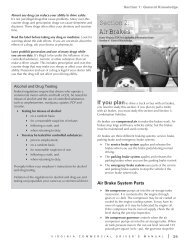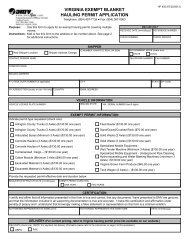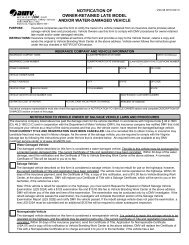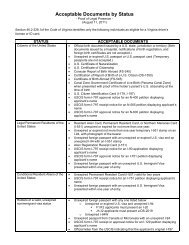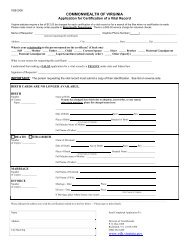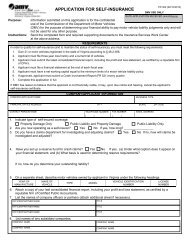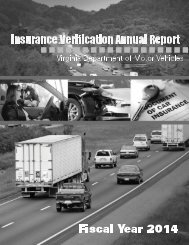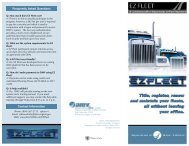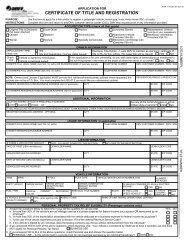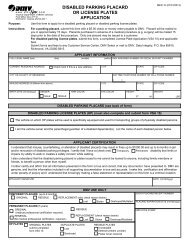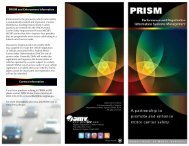Section 3: Safe Driving - Virginia Department of Motor Vehicles
Section 3: Safe Driving - Virginia Department of Motor Vehicles
Section 3: Safe Driving - Virginia Department of Motor Vehicles
You also want an ePaper? Increase the reach of your titles
YUMPU automatically turns print PDFs into web optimized ePapers that Google loves.
<strong>Section</strong> 3: <strong>Safe</strong> <strong>Driving</strong>Changing LanesBefore changing lanes, check your side and rearview mirrorsfor traffic approaching you from behind. Then, use your turnsignal to let other drivers know you plan to change lanes.Check for other drivers who also may be moving into thesame lane. Just before you begin moving into the other lane,quickly glance over your shoulder and check for any vehiclesthat may be in your blind spot.Whether you are changing lanes, passing, entering or exiting ahighway, always use your turn signals and check traffic to therear and sides. When driving on a multi-lane highway, stay inthe right lane if you are driving slower than the traffic aroundyou.More information about driving safely through a roundaboutis available at the <strong>Virginia</strong> <strong>Department</strong> <strong>of</strong> Transportation website at http://www.virginiadot.org/info/faq-roundabouts.asp.Tips for driving safely through a roundabout:As you approach the roundabout, slow down; look forthe street and direction signs. This will help you knowwhich exit to take. These signs should be posted alongthe roadside before you reach the roundabout.When you arrive at the roundabout, yield the right-<strong>of</strong>wayto pedestrians and bicyclists. You also must yieldto any vehicles already in the roundabout. Sometimesyour entry point will be controlled by a stop or yieldsign, or traffic signal. When the way is clear, you mayenter the roundabout.While inside the roundabout, stay in your lane until youare ready to exit. Use your vehicle’s right turn signal tolet drivers around you know what you want to do.Do not change lanes or take an exit before checkingfor vehicles that may be continuing through theroundabout in the lane next to you or behind you.Expect vehicles to be in blind spots you cannot see inyour rearview or side mirrors. Quickly glance over yourshoulder and check for any vehicles that may be in yourblind spot.PassingWhen passing another vehicle:check the traffic ahead <strong>of</strong> you, behind you and in yourblind spot before you attempt to pass. Signal and thenaccelerate to pass. Return to the right lane as soon asyou can see the front <strong>of</strong> the passed vehicle in yourrearview mirror.it is against thelaw to exceed thespeed limit as youpass.complete the passbefore you reacha No Passing zone.If you’re still in theleft lane when youreach the zone,you’re breakingthe law.you may passon the right ifthe vehicle youare passing hassignaled and ismaking a left turn. Be cautious because the vehicle youare passing may be blocking your view or blocking theview <strong>of</strong> other drivers. You may not pass on the right ifyou must drive <strong>of</strong>f the pavement or main portion <strong>of</strong> theroadway to get around the other vehicle.when approaching or passing a person riding a bicycle,moped, or power-assisted bicycle or other device,reduce speed and pass at least two feet to the left.When being passed, don’t speed up. Maintain a steadyspeed or slow down.16 | V I R G I N I A D R I V E R ’ S M A N U A L
<strong>Section</strong> 3: <strong>Safe</strong> <strong>Driving</strong>Passing is unlawful and unsafe:on hills, curves, at intersections or railroad crossings,except on roads with two or more lanes <strong>of</strong> trafficmoving in the same direction<strong>of</strong>f the pavement or shoulder <strong>of</strong> the roadwhen a school bus is stopped to load or unloadpassengers on a public road (unless a physical barrieror unpaved median separates traffic going in eitherdirection) or on a private roadwhen a solid line marks the left side <strong>of</strong> your laneOver-correctingOver-correcting occurs when the driver turns the steeringwheel more sharply than expected, causing the rear wheels <strong>of</strong>the vehicle to slide toward the outside <strong>of</strong> the turn. This mayresult in the loss <strong>of</strong> vehicle control.Most over-correction crashes are single vehicle crashes andare <strong>of</strong>ten preventable. A driver should remain alert at alltimes. Reduce speed and use extra caution while driving oncurved roads. If you veer <strong>of</strong>f the road, curved or straight, donot panic. Gradually reduce your speed, look in the directionyou want to go, slowly steer back onto the roadway.TurningTo make a right turn you should be in the lane closest tothe curb. Signal your intent to turn by using the properturn signal. You should signal at least three or four seconds,100 feet, ahead <strong>of</strong> the turn. Look to your left to check theintersection for pedestrians and traffic coming from the otherdirection. Then brake smoothly before and during the turn. Ifthere is a traffic light or a stop sign at the intersection, cometo a complete stop before you make the turn. Turn into thelane closest to the curb unless pavement markings lead youotherwise, and then change lanes if needed.To make a left turn you should be in the furthest left lanepossible, turning into the leftmost lane on the intersectingroad, unless pavement markings lead you otherwise; or,unless multiple left turn lanes are provided. If multiple leftturn lanes are provided, you should choose the lane that willbest serve your need once you enter the intersecting road.Signal your intent to turn by using the proper turn signal. Youshould signal at least three to four seconds, 100 feet, ahead <strong>of</strong>the turn. Look in all directions, checking the intersection forpedestrians and traffic coming from the opposite direction.Keep your front wheels pointed straight ahead until you areactually going to make the left turn. This prevents you frombeing pushed into oncoming traffic if another vehicle crashesinto you from behind. When the way is clear, make the leftturn, yield to any vehicles (including bicycles and pedestrians)approaching from the opposite direction.When two vehicles areapproaching each other andsignaling to turn left, bothvehicles should turn in front<strong>of</strong> each other so that thepassenger sides <strong>of</strong> thevehicles are beside eachother.U-TurnsU-turns are not legal everywhere. Before youmake a U-turn, check for No U-Turn or No LeftTurn signs. In business districts, cities and towns,U-turns are allowed only at intersections. Nevermake a U-turn on a highway.When making a U-turn, turn on your left-turn signal, stop,and yield for approaching traffic. When the way is clear,proceed into the outside or right hand lane traveling in theopposite direction.Turn SignalsWhen you plan to change lanes, turn, or enter or exit ahighway, first give the proper turn signal. Using your turnsignal, which is required by law, communicates your intendedmovement to drivers around you. Develop a good habit anduse turn signals or hand signals even if no other traffic is onthe road.When you plan to turn, signal three or four seconds, 100 feet,ahead <strong>of</strong> your turn. Be aware that drivers planning to turn intoyour lane may not know exactly where you will turn; driversmay pull out in front <strong>of</strong> you. Be alert.After you complete the turn or lane change, be sure the turnsignal stops flashing.Left TurnLeft hand andarm pointingstraight outHand SignalsRight TurnLeft hand andarm pointingupwardSlow or StopLeft hand andarm pointingdownwardV I R G I N I A D R I V E R ’ S M A N U A L | 17
<strong>Section</strong> 3: <strong>Safe</strong> <strong>Driving</strong>Maintaining a Space CushionSpace around your vehicle gives you distance to react inemergencies and avoid a crash. Create a space cushionaround your vehicle by staying in the middle <strong>of</strong> your lane.Make sure there is enough room ahead <strong>of</strong> your vehicle andbehind it for other vehicles to pass or stop safely.Use the two-, three- and four-second rule to determine ifyou are following far enough behind the vehicle ahead <strong>of</strong>you.Following DistanceAt these posted speeds and on dry surfaces,this distance, in seconds, allows the driver to steer andbrake out <strong>of</strong> a problem areas.2 seconds Under 35 MPH3 seconds 36-45 MPH4 seconds 46-70 MPHHere’s how the following distance rule works.Glance at the vehicleahead as it passes afixed object, such as anoverpass, sign, fence,corner or other fixedmark.Begin counting theseconds it takes you toreach the same placein the road.If you reach the markbefore you havecounted <strong>of</strong>f two,three, or four seconds,depending on speed,you’re following tooclosely. Slow down andincrease your followingdistance.For bad weatherconditions, heavytraffic, poor pavementor if your vehicle isin poor condition,add extra seconds toincrease your followingdistance.Drivers need to change following distance when speed orroad conditions change. Hand response time is close to ahalf second. Foot response time is normally three-quarters<strong>of</strong> a second. This does not take into account any delay inperception time as a result <strong>of</strong> the driver being tired, onmedication, distracted, etc. Road conditions, speed, driveralertness, and even following vehicles <strong>of</strong> different weights allchange the ability to stop.Increase your following distance when driving:behind a large vehicle that blocks your visionin bad weather or heavy trafficwhen exiting an expresswaybehind a motorcyclewhen being tailgatedTailgating is when the driver behind you is following tooclosely. If you find yourself in this situation, do not brakesuddenly. If possible, move over to another lane, or gentlytap your brakes to flash your brake lights and slow down. Thisshould encourage the tailgater to pass you or slow down.Help the driver behind you by maintaining a safe followingdistance and a steady speed. Tap your brakes to warn thedriver behind you when you plan to slow down or stop.SearchingSearching means looking at the entire scene for anything thatmight come into your path. As you search the road, avoidstaring at one thing. Keep your eyes moving and learn to readthe road and your surroundings.Looking ahead will help you identify risks early and provideyou with more time to react. Expert drivers try to focustheir eyes 20 to 30 seconds ahead. In the city, that equalsapproximately one block. Avoid staring at the middle <strong>of</strong> theroad. Scan from side to side, checking for traffic signs andsignals, cars or people that might be in the road by the timeyou reach them.Search for clues on the road. Look for exhaust smoke, brakeor back-up lights and turned wheels on vehicles. Clues likethese warn that the vehicles may pull into your path. Watchfor pedestrians, bicyclists and other slow moving vehicles thatmay be in the road ahead.When driving in rural areas, watch for hidden intersectionsand driveways, curves, hills and different road conditions.Watch for other vehicles, especially trucks, oversized andslow-moving farm vehicles, and bicycles.18 | V I R G I N I A D R I V E R ’ S M A N U A L
<strong>Section</strong> 3: <strong>Safe</strong> <strong>Driving</strong>Check from left to right and then left again beforeentering an intersection. Whenever you reach a place inthe road where other cars, people or animals may cross yourpath, look both ways to be sure it is clear. These includeintersections, crosswalks, shopping centers, construction areasand playgrounds. At any intersection, look to the left first,since cars coming from the left will be closer to you. Thenlook to the right and take one more quick look to the leftbefore you drive through.Look behind. Use your rearview mirror to check the trafficbehind you frequently, about every 10 seconds. This will alertyou if someone is moving up too quickly or tailgating you.Check the traffic behind you when changing lanes, backingup, slowing down quickly or driving down a long, steep hill.Blind SpotsBlind spots are danger areas that cannot be seen in themirrors on either or both sides <strong>of</strong> the vehicle.The best way to see a car in your blind spot is by quicklyturning your head and glancing over your shoulder to ensurethe way is clear before changing lanes or passing anothervehicle.Avoid driving in someone else’s blind spot. This can be just asdangerous as not checking your own blind spot. Speed up ordrop back; but, don’t stay in the other driver’s blind spot.Sharing the RoadDrivers share the road with many other users: pedestrians,bicyclists, moped and motorcycle riders, trucks and buses,recreational vehicles and other vehicles <strong>of</strong> all shapes andsizes. It is your responsibility to adjust your driving to avoidother drivers’ mistakes and assure everyone’s safety.Pedestrians: Generally, there are three types <strong>of</strong> pedestriansmost <strong>of</strong>ten involved in crashes: children, the elderly andadults under the influence <strong>of</strong> alcohol or other drugs.Be careful around schools, playgrounds and inresidential areas where small children may be playingor crossing the street.Look out for the elderly, who may have poor vision andhearing. Remember that the elderly and people withdisabilities will move slowly.Be especially aware <strong>of</strong> pedestrians when making aright or left turn. They have the right-<strong>of</strong>-way. Allowpedestrians to completely cross the street beforebeginning your turn.Be alert for pedestrians at all times. Slow down and beprepared to stop.Bicycles: Bicycles are considered vehicles andhave the same right-<strong>of</strong>-way as motor vehicles.Bicyclists are also expected to obey the sametraffic rules and regulations as vehicle drivers;however, many are children who may notknow or obey the rules. Slow down whenyou approach bicyclists. Give them plenty <strong>of</strong>room when passing and be prepared to stopsuddenly. Look for bicycles on all public roads.It is against the law to operate a bicycle or any electric powerdevice such as assistive mobility devices, toy vehicles, andbicycles on any interstate highway.Mopeds: Under <strong>Virginia</strong> law, a moped is a bicycle-like devicewith pedals and a motor. The motor cannot be rated at morethan two horsepower or enable the moped to travel morethan 30 MPH. It is against the law to operate a moped fasterthan 35 MPH or on an interstate highway. Any person whooperates a moped faster than 35 MPH is considered to beoperating a motorcycle which must meet <strong>Virginia</strong> registrationrequirements. In addition, the operator would be required tohold a valid driver’s license with a motorcycle classification ora driver’s license restricted to operating motorcycles only.Moped riders must be at least age 16 and obey all rules <strong>of</strong>the road. They must carry some form <strong>of</strong> identification thatincludes name, address and date <strong>of</strong> birth. As a driver, treatmoped riders with the same care given to any other vehicledriver.Although you do not need a driver’s license to operate amoped, you may not operate a moped if you have beendeclared a habitual <strong>of</strong>fender and your license is suspended orrevoked for driving while intoxicated.<strong>Motor</strong>cycles: Approximately half <strong>of</strong> all fatal motorcyclecrashes involve automobiles. Many crashes are caused by themotorist’s failure to see a motorcycle in traffic.Look for motorcyclists. In more than half <strong>of</strong> all crashesinvolving motorcycles and automobiles, the other driverdidn’t see the motorcycle until it was too late. Driversare conditioned to look for four-wheeled vehicles;but they don’t expect to see two-wheeled vehicles. Amotorcycle’s small size also makes it difficult to see.Check your blind spots. A motorcycle’s small size allowsit to slip into your blind spot easily. Always check formotorcycles before you pull out, change lanes, turn,back up or proceed through an intersection.Never tailgate a motorcycle (or any other vehicle).Allow yourself plenty <strong>of</strong> braking distance by adding anextra second to the following distance rule. In inclementweather, double this distance.Anticipate the motorcyclist’s movements. Although amotorcycle is not as wide as the lane, the rider will usethe entire lane as traffic situations and road conditionschange. A slight change or debris on the road surfaceV I R G I N I A D R I V E R ’ S M A N U A L | 19
<strong>Section</strong> 3: <strong>Safe</strong> <strong>Driving</strong>can be a major obstacle for a motorcyclist. Expect themotorcycle to make sudden moves within the lane.Never drive beside a motorcycle in the same lane.Yield to motorcycles. The small size <strong>of</strong> a motorcyclecan cause you to misjudge the motorcycle’s speed anddistance. Before pulling out into traffic, check twice formotorcycles and use extra caution before you pull outin front <strong>of</strong> one.Light Rail: There is a light rail train system in Norfolk calledThe Tide. Light rail trains share the road with motor vehiclesand bicyclists, and they intersect with motor vehicle traffic at27 locations along the 7.4 mile route. Stay safe when drivingaround The Tide by obeying the tips below.Pay attention to changing traffic patterns and alwaysfollow the roadway.Never drive around lowered crossing gates.Always look both ways before turning across train tracks.Expect trains on any track at any time.Always obey signs and traffic signals.Never stop, pass or shift on train tracks.Don’t cross train tracks unless you have enough room tocross without stopping and can clear the tracks to a safedistance.For more info about light rail safety, visit www.gohrt.com or call(757) 222-6100.Low Speed <strong>Vehicles</strong>: These electrically powered four-wheelvehicles have a maximum speed ranging from 21 to 25 MPH.Low speed vehicles may be operated on public roads withspeed limits <strong>of</strong> 35 MPH or less by licensed drivers or learner’spermit holders accompanied by a licensed driver. Low speedvehicles must comply with all federal safety standards and mustmeet <strong>Virginia</strong>’s requirements for passenger vehicle registrationand insurance coverage. Golf carts are not classified as lowspeed vehicles.Trucks, Tractor-Trailers, Buses and RVs: Trucks, tractortrailers,buses and recreational vehicles (RVs) – includingmotor homes, campers and travel trailers – are longer, higherand wider than other vehicles. They accelerate slowly andrequire greater stopping and turning distances. Plus, there aredanger areas around these vehicles where crashes are morelikely to occur. These areas are called No-Zones. No-Zones onthe side, front and rear also include blind spots where your cardisappears from the driver’s view. Learning the No-Zones cansave your life.Side No-Zones: Trucks, tractor-trailers, buses and RVshave big No-Zones on both sides that are dangerousbecause these vehicles must make wide turns. TheseNo-Zones or blind spots are much larger than your car’sblind spots. If you can’t see the driver’s face in his sideview mirror, then he can’t see you.Rear No-Zone: Trucks, tractor-trailers, buses and RVshave huge No-Zones directly behind them. The drivercan’t see yourcar behind hisvehicle and youcan’t see what’shappening intraffic ahead <strong>of</strong>his vehicle. Ifthe truck, busor RV brakes orstops suddenly,you have noplace to go andcould crash intothe vehicle’srear-end. Alwaysmaintain asafe followingdistance.Front No-Zone:You could get rear-ended by a truck, bus or RV if you cutin front too soon after passing the vehicle or if you cutin front and then suddenly slow down. The truck, busand RV drivers would be forced to slam on their brakes.These vehicles need nearly twice the time and room tostop as cars. A truck and its trailer may be as long as 65feet and it may take you more than half a mile <strong>of</strong> clearroad to pass. When passing, look for the entire front <strong>of</strong>the truck in your rearview mirror before pulling in front.And then, maintain your speed.Wide Turns: Trucks, buses and RVs sometimes need toswing wide to the left or right to safely make a turn. Theycan’t see the cars directly behind or beside them. In fact,their blind spots may stretch up to 20 feet in front <strong>of</strong>the cab and approximately 200 feet behind the vehicle.Never try to squeeze between a truck, bus or RV and thecurb or another vehicle.Light to Medium Trailers: These trailers are attached to midsizedcars and trucks with safety chains and a trailer hitch.Large side mirrors are generally needed to increase visibility.Towing a trailer places additional stress on the vehicle; it takesthe vehicle twice as long to pass, stop, accelerate and turn.Remember the No-Zones described under Trucks, Tractor-Trailers and RVs.Before driving a vehicle with a light to medium trailerattached, perform a safety inspection before each trip. Ensure:the pin securing the ball mount to the receiver is intactthe hitch coupler is securedsafety chains are properly attachedthe electrical plug is properly installedbrake lights, turn signals, and license plate lights arefunctioning properly.Before pulling a trailer on public roads, find a location such asa vacant parking lot to practice and get the feel for how yourvehicle and trailer will handle.20 | V I R G I N I A D R I V E R ’ S M A N U A L
<strong>Section</strong> 3: <strong>Safe</strong> <strong>Driving</strong>When driving a vehicle with a light to medium trailerattached:always allow for the added length <strong>of</strong> the trailer whenyou change lanesif your trailer starts to sway, steer toward your targetwhen backing up, place your hand on the bottom <strong>of</strong> thesteering wheel. If you cannot see where you are backingup, have someone outside to help guide you. To backthe trailer to the left, use your left hand to move thewheel left. To back the trailer to the right, use your righthand to move the wheel to the right.BackingThe most common mistake that drivers make when backingup is failing to look both ways behind them. Mirrors do notgive you a full view. To see as much as possible, turn yourbody and head to the right and look out through the rearwindow. Back up slowly and check for pedestrians andapproaching traffic by glancing quickly to either side.ParkingWhen parking on a public road, move as far from traffic aspossible. If you park on a shoulder, pull over as far on theshoulder as possible. If you park next to a curb, pull close toit. You may not park more than one foot from the curb. On atwo-way street, park on the right side <strong>of</strong> the road. On a onewayroad, park on either side.Parking on a hillYou may not park:beside another parked vehicle (double parking)on crosswalks or sidewalksin front <strong>of</strong> drivewayswithin areas where parking is prohibited by curbspainted yellow or No Parking signsin a parking space reserved for disabled personson the hard surface <strong>of</strong> a road when no curb is presentwithin 15 feet <strong>of</strong> a fire hydrantwithin 20 feet <strong>of</strong> an intersectionwithin 15 feet <strong>of</strong> the entrance to a fire, ambulance orrescue squad stationwithin 500 feet <strong>of</strong> where fire trucks or equipment arestopped answering an alarmwithin 50 feet <strong>of</strong> a railroad crossingin such a way that you block or create a hazard forother vehicles in a designated traffic laneVisibilityMost <strong>of</strong> what you do while driving depends on what yousee. To be a good driver, you need to know what to look for,where to look, and how to adjust to possible problems. Thesingle biggest contributor to crashes is failing to identify a risk.You must look down the road, to the sides, and behind yourvehicle. You must also be alert for unexpected events. Youmust use your headlights at night and at other times when it’shard to see. You must be alert and pay attention to what isgoing on around you.With a curb: Turn thefront wheels <strong>of</strong> yourvehicle to prevent itfrom rolling into thestreet.Without a curb: Turnthe front wheels sothat if the vehiclerolls, the rear <strong>of</strong> thevehicle will roll awayfrom traffic.Parkingdownhill —with curb Turnfront wheelsrightParking uphill— with curbTurn frontwheels leftLights<strong>Virginia</strong> law requires motorists to use headlights duringinclement weather such as rain, fog, snow or sleet whenvisibility is reduced to 500 feet. You must use your headlightswhenever you use your windshield wipers as a result <strong>of</strong> badweather.Hazardous Conditions<strong>Driving</strong> becomes hazardous when visibility is reduced orwhen the road surface is covered with rain, snow or ice.Reducing your speed should be your first response todecreased visibility and dangerous road conditions. Increaseyour space cushion by doubling your normal followingdistance from three seconds to six seconds (refer to theMaintaining a Space Cushion section for more information).Turn on your headlights.Parkingdownhill — nocurb Turn frontwheels rightParking uphill— no curbTurn frontwheels rightNight <strong>Driving</strong>At sunset, as soon as light begins to fade, turn on yourheadlights to make your vehicle more visible to others. Youmust use headlights from sunset to sunrise.V I R G I N I A D R I V E R ’ S M A N U A L | 21
<strong>Section</strong> 3: <strong>Safe</strong> <strong>Driving</strong>Use low-beams when driving in cities and towns, excepton streets where there is no lighting. Switch to low-beamswhenever you meet oncoming traffic to avoid blinding theother driver. When following, use low-beams whenever youare within 200 feet <strong>of</strong> the vehicle ahead.Use high-beam headlights on highways, unless anothervehicle is within 500 feet coming toward you. If the highbeams<strong>of</strong> an oncoming car are on, avoid looking directly atthe bright lights. Glance toward the side <strong>of</strong> the road, thenlook quickly ahead to determine the other vehicle’s position.Keep doing this until you have passed the other vehicle. Evenif the other driver does not dim his headlights, do not turn onyour high-beam headlights.FogFog reflects light and can reflect your own headlights back intoyour eyes. Use low-beam headlights in heavy fog and lookfor road edge markings to guide you. Even light fog reducesvisibility and your ability to judge distances, so slow down.Rain<strong>Driving</strong> in heavy rain can be as hazardous as driving in fog,especially if the wind is blowing. Other vehicles to the rearand in blind spot areas are especially difficult to see when it’sraining.Use your low-beam headlights to see and be seen. In lightrain or drizzle, turn on your windshield wipers to improvevisibility; using wipers for sprinkles may smear the windshieldand make it harder to see, so make sure you have windshieldwasher fluid.When rain begins, during the first half-hour, roads are morelikely to be slippery due to oil on the road surface mixing withwater.SnowRemove snow and ice from your entire car, including the ro<strong>of</strong>,hood and rear <strong>of</strong> the vehicle, before you start driving. Snowand ice left on the car can fly <strong>of</strong>f when the vehicle is movingand create a hazard for other motorists. Be sure to clear all <strong>of</strong>your windows, mirrors and front and rear lights <strong>of</strong> snow or iceso you can see and communicate with other drivers.Equip your car with all-weather snow tires or chains to helpprevent skidding and reduce stopping distance.<strong>Driving</strong> on packed snow is similar to driving on ice. When youbrake, apply the brakes gently. Slow down before stopping orturning.When driving on slippery surfaces and you need to stop,apply brakes gently. You have the most traction and controlwhen the front tires are rolling. Therefore, your vehicle willrespond more effectively to steering while moving moreslowly than hard braking.22 | V I R G I N I A D R I V E R ’ S M A N U A LWatch for ice on bridges and in shady areas. Bridges freezebefore other road surfaces.Dangerous <strong>Driving</strong> BehaviorsAggressive <strong>Driving</strong>This dangerous driving behavior is defined by <strong>Virginia</strong> lawas the intent to harass, intimidate, injure or obstruct anotherperson while committing one or more traffic <strong>of</strong>fenses suchas failing to stop or yield the right-<strong>of</strong>-way, avoiding a trafficcontrol device or failing to give way to an overtaking vehicle.When aggressive drivers are behind the wheel, thesehigh-risk drivers take out their anger on other motorists.Their frustration levels run high while their concerns for fellowmotorists run low. They break the law by running stop signsand red lights, speeding, tailgating, weaving in and out <strong>of</strong>traffic, passing on the right (including on the shoulder andunpaved portions <strong>of</strong> the road), making improper and unsafelane changes, as well as making hand and facial gestures,screaming, honking and flashing their lights.Protect yourself. If you see an aggressive driver, stay out <strong>of</strong>the way. Don’t challenge the aggressive driver by speeding upor trying to out-maneuver him. Avoid eye contact and ignorehis gestures and shouting.Remember, if you are convicted <strong>of</strong> aggressive driving, yourlicense could be suspended for ten days or for as long as sixmonths.Distracted <strong>Driving</strong><strong>Driving</strong> requires your full attention. There are manydistractions that may prevent drivers from focusing on driving:changing the radio or CD, talking to passengers, observingoutside surroundings, eating, using a cell phone and more.When on the road, drivers should not use cell phones,computers or other distracting devices except to report acrash or emergency. Before engaging in distracting behavior,pull over and stop the vehicle in a safe location.<strong>Virginia</strong> law prohibits drivers under age 18 from using cellphones or any other wireless communication device whiledriving except in a driver emergency and the vehicle islawfully parked or stopped. Text messaging or reading <strong>of</strong>text messages while driving is illegal for all drivers.Annually, driver distraction accounts for roughly 20 percent<strong>of</strong> all traffic crashes in <strong>Virginia</strong>. Why is distracted driving sodeadly? Because while the driver is distracted, the vehiclemay move into a high risk situation. The driver then losesprecious seconds before recognizing the situation and mustmake an emergency maneuver. Young distracted drivers areeven more susceptible. Failure to maintain proper control,following too closely, and not yielding the right-<strong>of</strong>-way arecommon actions <strong>of</strong> young distracted drivers. Inexperiencein handling or controlling a vehicle during an emergency
<strong>Section</strong> 3: <strong>Safe</strong> <strong>Driving</strong>situation combined with distracted driving (cell phone use,other passengers, eyes not on the road, etc.) puts them atgreater risk <strong>of</strong> a crash.Don’t let this happen to you. Take the following precautions.Concentrate. Keep your eyes on the road and yourhands on the wheel at all times. Also, keep your bodyalert; sit straight, but relaxed. Look in the direction thatyou want to go.Set or adjust the controls on the vehicle and otherdevices as soon as you get in the car and before youbegin driving.Do not use a cell phone.Anticipate the traffic and environment around you bysearching ahead and checking your rearview mirrors<strong>of</strong>ten.Maintain a space cushion around your vehicle. Makesure there is enough room ahead <strong>of</strong> your vehicle andbehind it.Drowsy <strong>Driving</strong>Constant yawning, head nodding, heavy eyelids, blurredvision and weaving while driving are some <strong>of</strong> the warningsigns that you may be on the verge <strong>of</strong> falling asleep at thewheel. <strong>Driving</strong> while you are sleepy reduces your abilityto drive effectively. Your reaction time is slower, awarenessis decreased, and judgment is impaired. Often the actions<strong>of</strong> tired drivers are confused with drivers who had beendrinking. The consequences can be just as fatal.To avoid falling asleep at the wheel:Get plenty <strong>of</strong> quality sleep before a trip.Avoid alcoholic beverages and heavy foods.Beware <strong>of</strong> medications that can impair your drivingability.Limit long distance driving. Stop at least every twohours for rest. Stop at a safe place and take a nap. Wait at least 10minutes after waking up to see how alert you are. If youdon’t feel any more alert, don’t drive. Find a place tosleep for an hour or for the night.If possible, drive with a companion and switch driverswhen necessary. Talk with passengers but not to thepoint <strong>of</strong> distraction.Keep the temperature cool in your vehicle. Keep youreyes moving and check your mirrors <strong>of</strong>ten.Avoid caffeine drinks. They provide a short-term boost;however, if you are seriously sleep deprived, no amount<strong>of</strong> caffeine will help. It’s best to stay <strong>of</strong>f the road.If possible, avoid driving when drowsiness is most likely,from 10 PM to 6 AM.Drinking and <strong>Driving</strong>Legally, drivers age 21 or older are considered to be drivingunder the influence (DUI) if your blood alcohol content(BAC) is .08 percent or higher. If your driving is impaired, youcan be convicted <strong>of</strong> driving under the influence with a BAClower than .08 percent. If under age 21, you can be convicted<strong>of</strong> illegal consumption <strong>of</strong> alcohol if your BAC is at least .02but less than .08. If your BAC is .08 or higher you could beconvicted <strong>of</strong> a DUI. If your driving is impaired because youare under the influence <strong>of</strong> any drug, you may face the samepenalties as driving under the influence <strong>of</strong> alcohol.Researchers estimate that between the hours <strong>of</strong> 10 PM and2 AM three out <strong>of</strong> every ten drivers are drunk. More thanone-third <strong>of</strong> these drivers have been drinking at someoneelse’s home. Nearly 50 percent <strong>of</strong> the drivers arrested forDUI are social to moderate drinkers. Don’t think that it won’thappen to you. In your lifetime, there’s a 50-50 chance thatyou’ll be involved in an alcohol-related crash.Just one alcoholic drink can affect your driving abilitybecause even a small amount <strong>of</strong> alcohol affects the brain’sfunctions – particularly vision, judgment, and coordination.Because alcohol affects your judgment and driving ability,your chances <strong>of</strong> being in a crash are seven times greater if youdrive after drinking than if you drive sober.Twelve ounces <strong>of</strong> beer is the same as a shot <strong>of</strong> liquor or afive-ounce glass <strong>of</strong> wine.Only time can decrease intoxication. C<strong>of</strong>fee, cold showers orexercise will not sober you up.Alcohol-related crashes are not accidents. They can beprevented! The only way to avoid the risks <strong>of</strong> drinking anddriving is to decide before you start drinking that you are notgoing to drive. Remember, alcohol affects judgment. Makingthe decision not to drive is a lot more difficult after one ortwo drinks.Drive to social events in groups <strong>of</strong> two or more and havethe driver agree not to drink.Combining alcohol with other drugs usually multiplies theeffects <strong>of</strong> both and can have a disastrous effect on yourability to drive. One drink taken when you are on anotherdrug – even an aspirin, or allergy or cold medicine – couldhave the same effect on your driving ability as drinking severalalcoholic beverages.Almost any drug can reduce your ability to drive safely. It’s notjust illegal drugs that cause problems. Many over-the-countermedications and prescription drugs for headaches, hay fever,colds, allergies or nervous conditions can cause drowsinessand dizziness. This includes syrups, drops, sprays, pills andtablets. They <strong>of</strong>ten affect driver alertness and slow reactiontime.V I R G I N I A D R I V E R ’ S M A N U A L| 23
<strong>Section</strong> 3: <strong>Safe</strong> <strong>Driving</strong>Read the label before taking any drug or medicine. Look forwarnings about side effects. If you’re uncertain about theeffects <strong>of</strong> a drug, ask your pharmacist or doctor for advice.Remember that, while the effects may vary among users, nodrug is harmless.Traffic CrashesIf you are involved in a traffic crash, you must:stop at the scene <strong>of</strong> the crash or as close to the sceneas possible without blocking traffic. You may move thevehicles before the police arrive if the vehicles create atraffic hazard.give any help you can if someone is injured. Do notattempt to move an injured person from a wreckedvehicle unless you have the necessary medical trainingor there is an immediate danger such as fire.report the crash to the police as quickly as possible.<strong>Motor</strong> vehicle crashes involving property damage,personal injury or death must be reported to the police.exchange information with other people involvedin the crash as soon as possible. Be sure to get thefollowing information:name, address and driver’s license number <strong>of</strong>other driverslicense plate numbers <strong>of</strong> other vehiclesname and address <strong>of</strong> anyone who was injuredname and address <strong>of</strong> each witnessname, address and insurance policy number <strong>of</strong>other vehicle ownersnotify your insurance company immediately.Law enforcement <strong>of</strong>ficers are required to forward a writtencrash report to DMV when a traffic crash results in injury orthe death <strong>of</strong> any person or total property damage is in excess<strong>of</strong> $1,500. All crash information will be recorded on the DMVrecords <strong>of</strong> each driver involved in the crash.You must make a reasonable effort to find the owner <strong>of</strong> anunattended vehicle or other property damaged in a crash.If you cannot locate anyone, leave a note that can be foundeasily at the scene <strong>of</strong> the crash. Include your name, telephonenumber, the date and time <strong>of</strong> the crash, and a description<strong>of</strong> the damage. You must also report the crash to the policewithin 24 hours.24 | V I R G I N I A D R I V E R ’ S M A N U A LDeer HazardsThousands <strong>of</strong> deer-vehicle crashes take place in <strong>Virginia</strong> eachyear, resulting in fatalities, injuries and costly vehicle damage.To avoid hitting a deer:Be alert at dusk and dawn especially in the fall.Slow down if you see a deer near or crossing the road.Deer frequently travel in groups; there are likely moredeer nearby.Use the horn to scare deer away.If a collision with a deer or other animal is unavoidable,do not swerve. Brake firmly, stay in your lane, and cometo a controlled stop.If you hit a deer, report it to law enforcement.Traffic StopsIf you are stopped by a police <strong>of</strong>ficer:Remain calm.Pull <strong>of</strong>f to the right side <strong>of</strong> the roadway. Position yourvehicle as far away from traffic as possible.Turn on your flashers.Turn <strong>of</strong>f your engine, radio and any other device thatcould block communication with the <strong>of</strong>ficer.Roll down your window so that you can communicatewith the <strong>of</strong>ficer.Keep your safety belt fastened and ask your passengersto keep their belts fastened.Stay in your vehicle. Do not get out unless the <strong>of</strong>ficerasks you to.Keep your hands in plain view, preferrably on thesteering wheel. Ask your passengers to keep their handsin plain view also.Do not make any movement that will make the <strong>of</strong>ficerthink you are hiding or reaching for something.Carry proper identification: a valid driver’s license, pro<strong>of</strong><strong>of</strong> vehicle registration and pro<strong>of</strong> <strong>of</strong> insurance. If the<strong>of</strong>ficer asks for these documents, tell him where theyare and reach for them slowly, keeping one hand on thesteering wheel.If the <strong>of</strong>ficer is driving an unmarked car or is not inuniform, ask to see his or her identification.Answer the <strong>of</strong>ficer’s questions fully and clearly. If youdon’t understand something, politely ask the <strong>of</strong>ficerquestions to clarify.If the <strong>of</strong>ficer issues you a citation, do not argue with the<strong>of</strong>ficer about the citation. You will have your chance tomake your case when you go to court.You will be asked to sign the citation. This is not anadmission <strong>of</strong> guilt. Refusal to sign the citation may resultin your arrest. Or, you may be required to go to thepolice station.



